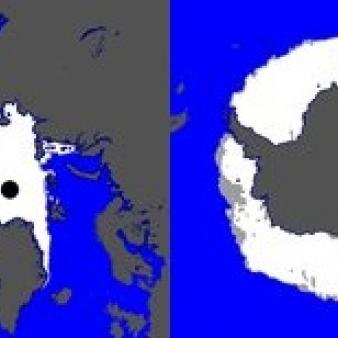 Licensed under CC BY 4.0 by EUMETSAT
Licensed under CC BY 4.0 by EUMETSAT
Global Sea Ice Edge
Operational Near real time productIce classes are assigned from atmospherically corrected SSMIS and AMSR-2 brightness temperatures and ASCAT backscatter values, using a Bayesian approach. Both the sea ice edge product and the sea ice type product are classification products differing between different ice classes. Sea ice edge differs between the classes open water, open ice, and closed ice which are defined from the ice concentration thresholds of 30 % and 70 %, respectively. The product series is operational since 2005.
Identification
Acronym : GBL SIED
Product navigator reference :
EO:EUM:DAT:MULT:OSIEDGBN
OSI SAF producer : Norwegian Meteorological Institute
Identifier : OSI-402-d
Digital object identifier (DOI) 10.15770/EUM_SAF_OSI_NRT_2005
Acronym for EDC (APNM) : OSIEDGBN
License/Attribution : See at bottom
Characteristics
Processing level : L3
Satellite input : DMSP/SSMIS, GCOM-W/AMSR-2 and Metop/ASCAT
Other input : ECMWF forecast for atmospheric correction
Temporal sampling : 1 per day
Central time : 12:00
Timeliness :
?
The timeliness is the time elapsing from the sensing time of the last contributing file to the product dissemination to users. It is similar to the latency.
5 h
Spatial coverage : Global
Spatial sampling : 10 km
File Formats : HL FTP Server (NetCDF4), EDC (NetCDF4), EUMETCast (NetCDF4)
Characteristics & methods : Discrimination Open ice/Closed ice/No ice. Multisensor analysis, daily average. Risk mitigation against sensor degradation.
Data Access
OSI SAF FTP server (last 31 days)
ftp://osisaf.met.no/prod/
Directory: ice/edge/
OSI SAF FTP server (archive)
ftp://osisaf.met.no/archive/
Directory: ice/edge/
OSI SAF Thredds
EUMETSAT Multicast
Accuracy Requirements
Target accuracy : 20 km (yearly average)
Verification/validation method : Comparison with high resolution manual ice charts
Applications and users
Usage : NWP and Ocean/Ice models, operational Met and Sea Ice services.
History
Authorised to be operational / released :
Declared operational / released since :
On EUMETCast since :
On EDC since :
On FTP server since :
First date :
Full series temporal coverage : 2005-onwards
Detailed history :
The product series is operational since 2005:
- version OSI-402 from 2005 to 15/09/2015
- version OSI-402-b from 15/09/2015 to 30/05/2017
- version OSI-402-c from 30/05/2017 to 03/06/2021 (inputs from Metop-A and -B, NetCDF3)
- version OSI-402-d since 03/06/2021 (inputs from Metop-B and -C, NetCDF4). Introducing associated uncertainty fields: the uncertainty field replaces the previous ‘confidence level” variable which will disappear. The confidence level can be reconstructed from the new uncertainty variable.
License/Attribution
License/Attribution : OSI SAF Global Sea Ice Edge, OSI-402-d, doi: 10.15770/EUM_SAF_OSI_NRT_2005. EUMETSAT Ocean and Sea Ice Satellite Application Facility. Data extracted from [distributor/distribution mean]: ([extracted period],) ([extracted domains],) accessed [download date]
The content within square brackets "[…]" is to be replaced with whatever distributor, period, domain or download date is relevant to the data being used. The "extracted period" and "extracted domains" are only needed if a subset of the data is being used.
Suggestions for "distributor/distribution mean": OSI SAF FTP server/the EUMETSAT Data Centre/EUMETCast/name and URL of a redistributor...
The content within square brackets "[…]" is to be replaced with whatever distributor, period, domain or download date is relevant to the data being used. The "extracted period" and "extracted domains" are only needed if a subset of the data is being used.
Suggestions for "distributor/distribution mean": OSI SAF FTP server/the EUMETSAT Data Centre/EUMETCast/name and URL of a redistributor...
Comments
New ticket helpdesk

Using Metop-B and -C, instead of Metop-A and -B (in OSI-402-c)
Switching from NetCDF3 to NetCDF4 as product format
Introducing associated uncertainty fields. The uncertainty field replaces the previous ‘confidence level” variable which will disappear. The confidence level can be reconstructed from the new uncertainty variable.